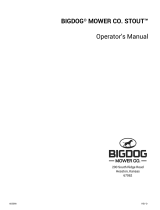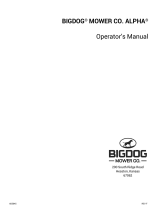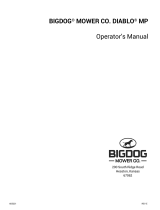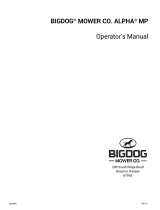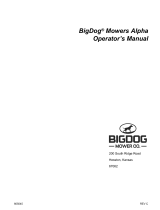
3Section 2 — important Safe operation practiceS
37. When operating this machine in the
forward or reverse direction, do not
allow the ground speed control levers
to return to the neutral position on their
own. Always maintain a firm grip on the
levers, operate them smoothly and avoid
any sudden movements of the levers
when starting or stopping.
Slope Operation
Slopes are a major factor related to slip and
fall accidents, which can result in severe injury.
Operation on slopes requires extra caution. If
you feel uneasy on a slope, do not mow it. For
your safety, use the slope gauge included as
part of this manual to measure slopes before
operating this machine on a sloped or hilly
area. If the slope is greater than 15 degrees, do
not mow it.
Do:
1. Mow across the face of slopes; never up
and down. Always turn up hill. Exercise
extreme caution when changing
direction on slopes.
2. Watch for holes, sprinkler heads, ruts,
rocks, hidden objects, or bumps which
can cause you to slip or trip. Tall grass
can hide obstacles.
3. Always be sure of your footing. A slip
and fall can cause serious personal
injury. Check the area thoroughly before
mowing. Slow down and use extra care.
Do Not:
1. Do not mow near drop-offs, ditches
or embankments, you could lose your
footing or balance.
2. Do not mow slopes greater than 15
degrees as shown on the slope gauge.
3. Do not mow on wet grass. Unstable
footing could cause slipping.
WARNING
Do not mow up and down the slope. You could slip and
slide into the mower, or the mower could loose traction
and steering control.
Children
Tragic accidents can occur if the operator is not
alert to the presence of children. Children are
often attracted to the mower and the mowing
activity. They do not understand the dangers.
Never assume that children will remain where
you last saw them.
1. Keep children out of the mowing area
and under watchful care of a responsible
adult other than the operator.
2. Be alert and turn mower off if a child
enters the area.
3. Before and while moving backwards,
look behind and down for small children.
4. Use extreme care when approaching blind
corners, doorways, shrubs, trees, or other
objects that may obscure your vision of a
child who may run into the mower.
5. Keep children away from hot or running
engines. They can suffer burns from a
hot muffler.
6. Do not allow anyone to operate or
maintain this machine who has not read
the manual. Never allow children under
16 years of age to operate this machine.
Hydraulic Devices & Systems
Hydraulic fluid escaping under pressure may
have sufficient force to penetrate skin and to
cause serious injury. If foreign fluid is injected
into the skin, it must be surgically removed
within a few hours by a doctor familiar with this
form of injury, or gangrene may result.
WARNING
Keep body and hands away from pinholes or nozzles
that could eject hydraulic fluid under high pressure.
Use paper or cardboard, not hands, to search for leaks!
Safely relieve all pressure in the system before
performing any work on the system, and make
sure that:
• The ignition switch is OFF
• The key is removed
• The engine spark plug wire(s) removed
• All connections to the negative terminal
of the battery are removed
• The park brake is set
• All by-pass valves, if so equipped, are open
• Hydraulic controls are actuated to release
pressure on pumps, cylinders, etc. If “float”
positions are available, they should be used.
After the above operations are completed, it
should be safe to begin disconnecting the lines
or components. It is still a good idea to cover
the connection with a cloth shield and then
gently loosen connections.
WARNING
Make sure all hydraulic fluid connections are tight
and all hydraulic hoses and lines are in good condition
before applying pressure to the system.
Service
Safe Handling Of Gasoline:
1. To avoid personal injury or property
damage use extreme care in handling
gasoline. Gasoline is extremely
flammable and the vapors are explosive.
Serious personal injury can occur when
gasoline is spilled on yourself or your
clothes, which can ignite. Wash your skin
and change clothes immediately.
2. Use only an approved gasoline container
and fill slowly to decrease the chance of
static electricity buildup and spillage.
3. Never fill containers inside a vehicle or on
a truck or trailer bed with a plastic liner.
Always place containers on the ground
away from your vehicle before filling.
4. Remove gas-powered equipment from
the truck or trailer and refuel it on the
ground. If this is not possible, then
refuel such equipment on a trailer with
a portable container, rather than from a
gasoline dispenser nozzle.
5. Keep the nozzle in contact with the rim
of the fuel tank or container opening at
all times until fueling is complete. Do not
use a nozzle lock-open device.
6. Extinguish all cigarettes, cigars, pipes
and other sources of ignition.
7. Never fuel machine indoors because
flammable vapors will accumulate in
the area.
8. If the fuel container spout will not fit
inside the fuel tank opening, use a funnel.
9. If the fuel tank has to be drained, do this
outdoors.
10. Never remove gas cap or add fuel while
engine is hot or running. Allow engine to
cool at least two minutes before refueling.
11. Never over fill fuel tank. Fill the tank to
the bottom of the filler neck, allowing
some space in the tank for fuel expansion.
12. Replace gasoline cap and tighten securely.
13. If gasoline is spilled, wipe it off the
engine and equipment. Move machine
to another area. Wait 5 minutes before
starting engine.
14. Never store the machine or fuel
container near an open flame, spark or
pilot light as on a water heater, space
heater, furnace, clothes dryer or other
gas appliances.
15. To reduce fire hazard, keep machine free
of grass, leaves, or other debris build-up.
Clean up oil or fuel spillage and remove
any fuel soaked debris.
16. Allow machine to cool at least 5 minutes
before storing.
General Service:
WARNING
Never let children or untrained people operate or service
this mower.
1. Never run an engine indoors or in a
poorly ventilated area. Engine exhaust
contains carbon monoxide, an odorless
and deadly gas.
2. Before cleaning, repairing, or inspecting,
make certain the blade and all moving
parts have stopped. Disconnect the
spark plug wire and ground against the
engine to prevent unintended starting.
3. Check the blade and engine mounting
bolts at frequent intervals for proper
tightness. Also, visually inspect blade
for damage (e.g., bent, cracked,
worn) Replace blade with the original
equipment manufacture’s (O.E.M.)
blade only, listed in this manual. Use of
parts which do not meet the original
equipment specifications may lead to
improper performance and compromise
safety!
4. Mower blades are sharp and can cut.
Wrap the blade or wear gloves, and use
extra caution when servicing them.
5. Keep all nuts, bolts, and screws tight to
be sure the equipment is in safe working
condition.
6. Never tamper with safety devices. Check
their proper operation regularly.
7. If you hit a solid object while mowing,
disengage the blade clutch, place the
neutral latch levers in the neutral lock
position, shift the transmission into
neutral and stop the engine. Disconnect
the spark plug wire(s) and inspect for
damage. Repair any damage and make
sure the blades are in good condition
and the blade bolts are tight before
restarting the engine.





















